Have you ever noticed the circular plaque at the rear of City Hall on College Street dedicated to ‘the pioneer of cinematography’? It’s looking a little shabby these days and has been moved from its original location, but it was created to mark the birthplace of photographer, inventor and film-maker William Friese-Greene.
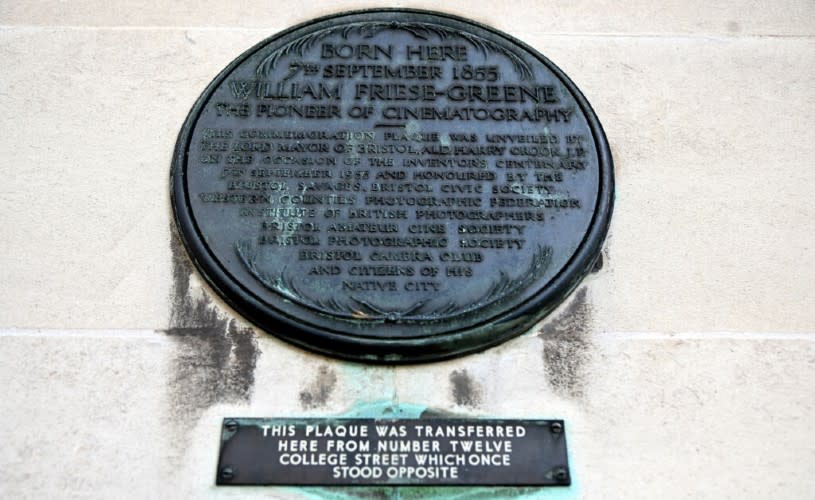
Image credit - Bhagesh Sachania Photography
Who was William Friese-Greene?
As an inventor, William Friese-Greene had over 70 patents to his credit. These included one of the very first movie cameras. He came from a family of modest means and died in poverty but enjoyed periods of wealth, thanks, in part, to the success of his inventions relating to printing as well as his string of photographic studios.
Friese-Greene’s profits were eaten up by the cost of his moving picture experiments and his neglect of his day-to-day business. He was declared bankrupt in 1891, losing his substantial studio chain. He was bankrupted twice more – in 1903 and 1910 – because of all he spent on his inventions, including in his later years the early development of colour film.
When he died in London on 5 May 1921, moments after speaking about the need for unity at an ill-tempered meeting of film distributors, it is thought that the only money he had was the 1s. 10d in a coin purse in his pocket, the price of a cinema ticket at that time.
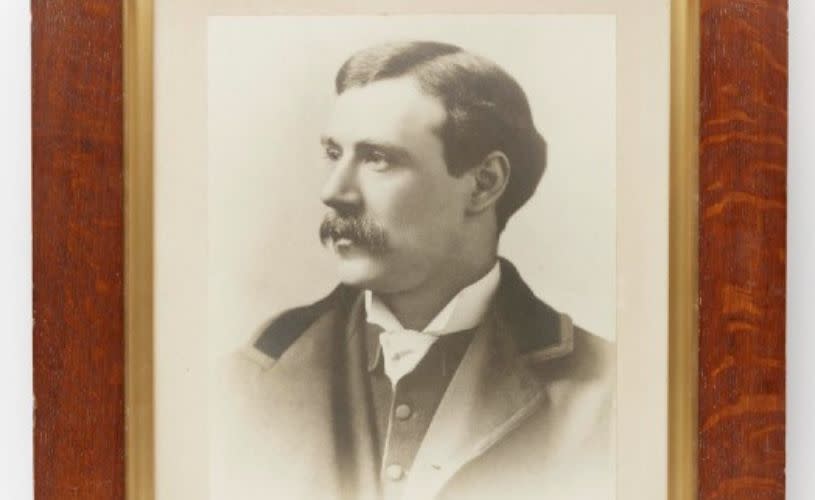
Framed photograph of William Friese-Greene taken by T C Leaman, Bath, 1889 (Science Museum Group, object 1994-5014/1, Creative Commons Attribution-NonCommercial-NoDerivs 4.0 Licence).
Where was William Friese-Greene born?
William Friese-Greene was born on 7 September 1855 at 68 College Street (later renumbered 12). He was the youngest of seven siblings and his father was a metal worker.
The City Hall plaque was originally attached to his old house and was unveiled in September 1955 to mark the centenary of his birth. The 1955 commemorations were organised by local photographer Reece Winstone.
Despite appeals to turn the house into a museum of cinematography, 12 College Street was demolished in 1958 to create parking spaces for six cars. The plaque was relocated to its present site in May 1959.
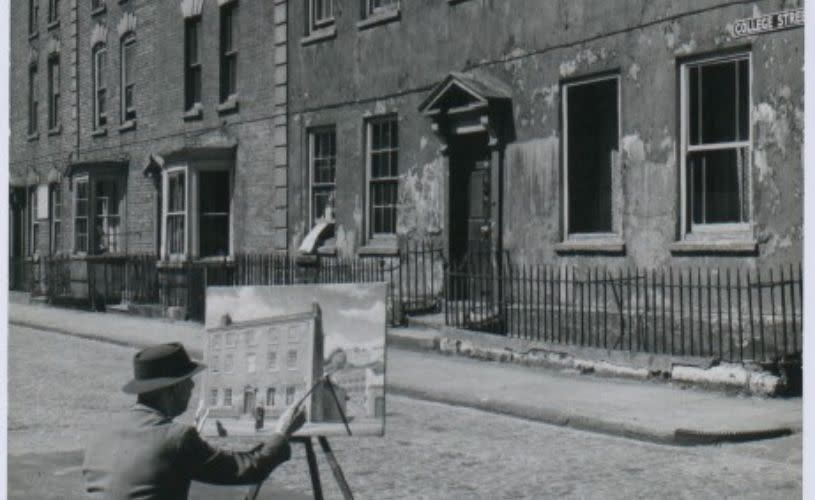
W H Truman painting Friese-Greene’s former home in 1955. The painting was purchased by William’s son Graham and now hangs in the office of the headmaster of Queen Elizabeth's Hospital school (Bristol Archives: 40826/BUI/31).
How did he begin his career as a photographer?
At the age of ten, Willie Green (as he was then known) won a scholarship place for four years’ education at Queen Elizabeth’s Hospital school on Brandon Hill. He left in 1869.
In March 1871, QEH paid for Willie to take up an apprenticeship with the Polish portrait photographer Marcus Guttenberg. There’s a commemorative plaque at 67 Queens Road to mark this landmark occasion, erected in 1949 by the Queen’s Road Traders’ Association.
This plaque has the wrong start date (1869 instead of 1871). It also has the location wrong, according to Peter Domankiewicz, the film-maker and journalist who has undertaken extensive research about Friese-Greene’s life, work and legacy. By May 1870 Guttenberg was advertising his studio as being at 17 Royal Promenade, not his former place on Queen’s Road.
The finish date on the plaque is also likely to be incorrect. It says the apprenticeship continued to 1875, but in 1874 Willie must have brought the apprenticeship to a premature end. This was the year he married Helena Friese at St George’s and the couple moved to Bath so he could open the first of a series of photographic studios. These eventually included branches in New Bond Street, Piccadilly and the King’s Road in London, Plymouth, Brighton and here in Bristol.
Willie took the highly unusual move of adding Helena’s surname to his, along with an extra ‘e’ for balance, and thus became William Friese-Greene.
What did Friese-Greene achieve in filmmaking?
Despite what that plaque on City Hall says, it’s probably more accurate to talk of Friese-Greene as being ‘a pioneer’ of cinema rather than ‘the’ one. A modest man, he was generous in acknowledging the achievements of his contemporary inventors in the field of capturing movement on film.
However, a significant milestone in his career was the patent granted by the British Patent Office on 21 June 1889. This was for a motion-picture film camera that he had developed in collaboration with a civil engineer, Mortimer Evans. It embodied most of the principles of future motion picture cameras.
Friese-Greene sold the rights to the camera to City of London investors for a substantial sum, but they didn’t keep up the patent payments. This subsequently lapsed, while Friese-Greene was bankrupt and unable to buy it back in time.
Other collaborations included working in Bath in the early 1880s with the scientific instrument maker John Arthur Roebuck Rudge on a variety of devices for showing photographs in rapid succession from glass plates, and a camera developed in 1890 with Frederick Varley to shoot stereoscopic/3D moving images.
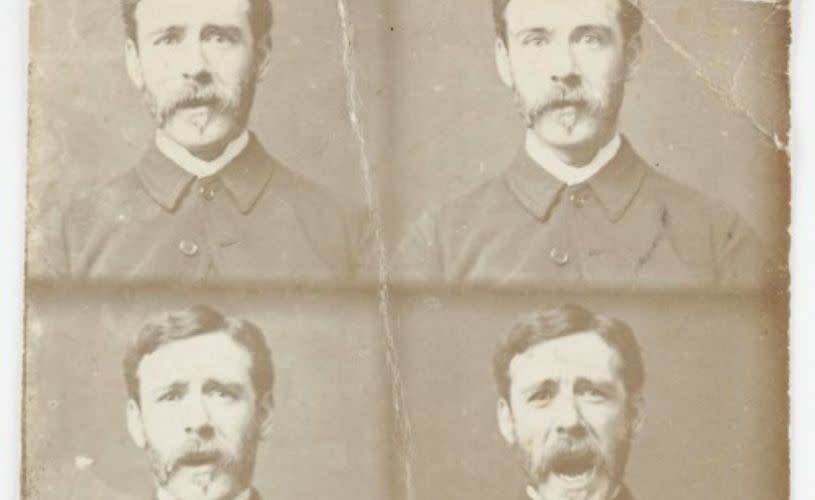
William Friese-Greene. Sequences of images taken about 1885 to recreate movement. These cyclical sequences were projected using a lantern designed by John Arthur Roebuck Rudge (Science Museum Group, objects 1994-5014/6, Creative Commons Attribution-NonCommercial-NoDerivs 4.0 Licence).
Friese-Greene wrote to the American inventor Thomas Edison in early 1890 describing what he had achieved with the hope they might work together. Edison claimed to already have a working film camera, which was untrue.
Friese-Greene was later a witness in a New York court case, appearing on behalf of a group of independent film producers challenging Edison’s patents. Friese-Greene’s testimony helped break the Edison monopoly on film production and distribution, as his 1889 patent pre-dated that of Edison’s more famous 1891 Kinetograph Camera, which contained many of the same principles.
What was Friese-Greene’s reputation when he died?
When Friese-Greene died, he was a largely forgotten man. In an abrupt about-turn, the film industry was stirred to make up for its neglect, paying for a lavish funeral and memorial at Highgate, and dimming the lights of cinemas at the moment of his interment. The first memorial plaque to be unveiled in the city of his birth was at the Orpheus in Henleaze in 1939.
Having been rediscovered shortly after his death, Friese-Greene achieved some posthumous acclaim. A sympathetic – and romanticised biography – by Ray Allister was published in 1948. This was Friese-Greene, Close Up of An Inventor and it became the basis for the Festival of Britain biopic The Magic Box. The film was a commercial and critical flop but Martin Scorsese has many times cited it as one of his favourites, and one that inspired him.
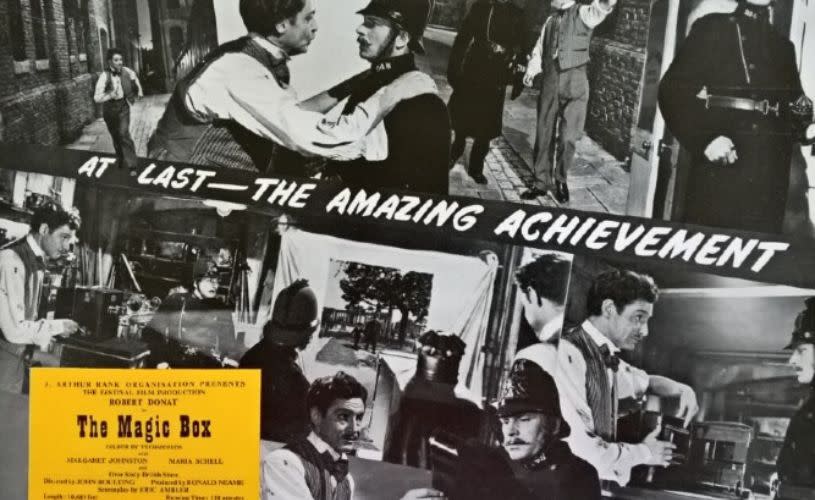
Page from the original pressbook produced as part of the promotional campaign for The Magic Box (Rank Organisation, 1951).
However, attitudes began to change in 1955 when Brian Coe, an historian of photographic technology, wrote his first article on Friese-Greene.
Coe based his research on the examination of material in photographic journals during the narrow period of Friese-Greene’s initial experimentation and concluded that he had nothing to do with the invention of moving pictures. He also accused him of stealing other people’s idea. Many other historians of early cinema were happy to agree with him.
Peter Domankiewicz thinks Coe took a very narrow view and he is working to restore Friese-Greene’s reputation. He believes the evidence of Friese-Greene stealing other people’s ideas doesn’t hold up, but that there is evidence of other people taking credit for his ideas.
You might also like:





